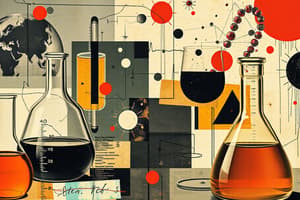Podcast
Questions and Answers
What are organisms composed of?
What are organisms composed of?
Matter
What is matter?
What is matter?
Anything that takes up space and has mass. It is made up of elements.
What is an element?
What is an element?
A substance that cannot be broken down into other substances by chemical reactions.
What is a compound?
What is a compound?
What elements make up 96% of living matter?
What elements make up 96% of living matter?
What does each element consist of?
What does each element consist of?
What is an atom?
What is an atom?
What are atoms composed of?
What are atoms composed of?
What are the three relevant subatomic particles?
What are the three relevant subatomic particles?
What are the charges for neutrons, protons, and electrons?
What are the charges for neutrons, protons, and electrons?
Where are the neutrons, protons, and electrons located?
Where are the neutrons, protons, and electrons located?
What are neutron mass and proton mass measured in?
What are neutron mass and proton mass measured in?
What is an element's atomic number?
What is an element's atomic number?
What is an element's mass number?
What is an element's mass number?
What is atomic mass?
What is atomic mass?
All atoms of an element have the same number of protons but may differ in the number of what?
All atoms of an element have the same number of protons but may differ in the number of what?
What are isotopes?
What are isotopes?
What is the definition of energy?
What is the definition of energy?
What is potential energy?
What is potential energy?
What is an energy level or electron shell?
What is an energy level or electron shell?
What determines the chemical behavior of an atom?
What determines the chemical behavior of an atom?
What are valence electrons?
What are valence electrons?
What is a covalent bond?
What is a covalent bond?
What is a molecule?
What is a molecule?
What is a structural formula?
What is a structural formula?
What is a compound?
What is a compound?
What is electronegativity?
What is electronegativity?
What is a nonpolar covalent bond?
What is a nonpolar covalent bond?
What is a polar covalent bond?
What is a polar covalent bond?
What are ionic bonds?
What are ionic bonds?
What is an ion?
What is an ion?
What is a cation?
What is a cation?
What is an anion?
What is an anion?
Is a covalent bond a strong bond?
Is a covalent bond a strong bond?
What are weak chemical bonds?
What are weak chemical bonds?
What are hydrogen bonds?
What are hydrogen bonds?
Flashcards are hidden until you start studying
Study Notes
Composition of Organisms
- Organisms are composed of matter.
Matter Defined
- Matter is anything that occupies space and possesses mass, formed from elements.
Elements
- An element is a pure substance that cannot be decomposed into simpler substances through chemical reactions.
Compounds
- Compounds consist of two or more elements bonded together in a constant ratio, exhibiting unique characteristics compared to their elemental components.
Elements in Living Matter
- Carbon, hydrogen, oxygen, and nitrogen constitute 96% of living matter.
Atoms
- Each element is comprised of unique atoms, which are the smallest units of matter retaining elemental properties.
Atomic Structure
- Atoms consist of subatomic particles: neutrons, protons, and electrons.
Subatomic Particles
- Neutrons carry no electrical charge, protons are positively charged, and electrons hold a negative charge.
- Neutrons and protons reside within the atomic nucleus, while electrons form a surrounding cloud.
Atomic Measurements
- Neutrons and protons' mass is measured in daltons.
- Atomic number refers to the number of protons in an atom's nucleus.
- Mass number is the total of protons and neutrons within the nucleus.
- Atomic mass approximates an atom's total mass and often correlates with the mass number.
Isotopes
- Atoms of the same element may vary in neutron count, leading to the formation of isotopes.
Energy Concepts
- Energy is defined as the capacity to cause change.
- Potential energy is the energy possessed by matter due to its position or structure, particularly the varying potential energy levels of electrons.
Electron Configuration
- Electron shells represent the potential energy states of electrons.
- Chemical behavior of atoms is dictated by electron distribution, especially valence electrons, found in the outermost shell.
Chemical Bonds
- Valence electrons are located in the outermost shell.
- Covalent bonds involve sharing pairs of valence electrons between atoms, enhancing each atom's valence configuration.
- Molecules are formed from two or more atoms linked by covalent bonds; single bonds share one pair, while double bonds share two pairs of valence electrons.
Bonding Notation
- Structural formulas notation represents atomic connections and bonding patterns.
Electronegativity
- Electronegativity measures an atom's pull on shared electrons within covalent bonds; higher electronegativity indicates a stronger attraction.
Types of Bonds
- Nonpolar covalent bonds have equal sharing of electrons, while polar covalent bonds involve unequal sharing due to differing electronegativities.
- Ionic bonds occur through attraction between anions (negatively charged ions) and cations (positively charged ions), often involving electron transfer.
Ionic and Covalent Bonds
- Covalent bonds are considered strong chemical bonds, while weak chemical bonds include hydrogen bonds, ionic interactions, and van der Waals forces.
Hydrogen Bonds
- Hydrogen bonds form between a hydrogen atom covalently bonded to an electronegative atom and another electronegative atom.
Additional Weak Bonds
- Further weak bonds include hydrophobic and hydrophilic interactions, alongside van der Waals forces, which arise from transient molecular interactions.
Studying That Suits You
Use AI to generate personalized quizzes and flashcards to suit your learning preferences.




